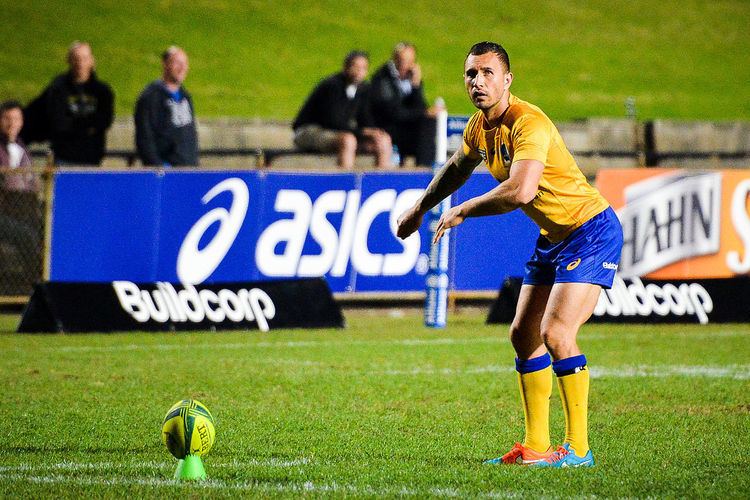 | ||
The place kick is a kicking style commonly used in rugby union, rugby league, association football, American football and Canadian football.
Contents
American and Canadian football
Place kicks are also used in American football and Canadian football for kickoffs, extra points, and field goals (a variation is the Squib kick). The place kick is one of the two most common forms of kick in gridiron-based football codes, along with the punt. The punt, however, cannot score points (except in Canadian football where it counts as a single). The place kick is the nearly exclusive method of kicking in arena football as well as most other indoor football leagues, since punting is not legal in arena football.
It typically involves placing the ball on the ground. To keep the ball in position, a mound of sand, a hole in the turf, or a plastic tee is sometimes used. A holder is required to hold a ball upright during field goal and extra point attempts; a holder can also be used during kickoffs, but is usually only used when weather conditions prevent the ball from standing on its tee by itself.
In American football a place kick is worth one point for PATs (Point After Touchdown) or three points for field goals, except in six-man football where it is worth two points.
In the comic strip Peanuts, Lucy frequently holds the football to allow Charlie Brown to place kick but invariably pulls it away at the last second.
Australian football
The technique was once used in Australian rules football when kicking for goal, but fell out of favour in the mid-20th Century in favour of the Drop punt.
Rugby league
The place kick is commonly used in rugby league for kick offs and most kicks at goal (penalty goals and conversions).
The lack of a consistently successful place kicker in a team can be detrimental to a team. Anybody on the team can take a penalty or conversion kick although there is often a regular kicker. Sometimes teams will use different players to kick depending on what side of the field the kick is to be taken from.
Place of kick
Kick offs are taken from the centre of the halfway line. A kick at goal from a penalty kick can be taken at any point along an imaginary line parallel to the touchline between the place the offence was marked by the referee and the kicker's goal line. Conversion attempts may be taken at any point along an imaginary line parallel to the touchline from where the try was scored.
Placing the ball
Most kickers use some form of aid to allow them to strike a preferred part of the ball. Popular aids used include kicking tees and mounds of sand on which to place the ball. Players might also use their boot to mould the ground where the ball will be placed, making a divot behind the ball to allow greater access to the kicking foot.
Kickers attempt to position the ball in a way that allows them to kick the ball's "sweet spot". Kicking the sweet spot will result in the ball travelling further and is located about a third of the way up the ball.
Kick
The most common kicking style is the round-the-corner kick, which tends to hook the ball to the left for a right footed kicker.
Kickers usually pace out their kick before taking it. This begins with the kicker standing over the ball with their feet in kicking positions. They then measure out a run up. When the ball is kicked, usually with the instep of the foot, the kicker will follow through with their swing.
Most of the top kickers can kick a goal from approximately 55m, or just inside their own half.
Rugby union
In rugby union, the most common position for a goal kicker to play is fly-half as that position requires good kicking skills from hand. Slightly less commonly, the full back will kick (another position which requires kicking from hand). If the goal kicker is neither of those two positions, the remaining three-quarter backs and scrum-half might kick. Goal kicking forwards are extremely rare, but not unknown, the most exception in recent years having been the Australian second row John Eales.
Association football
Place kicks in association football are the corner kick, free kick, goal kick, Kick-off and penalty kick.
